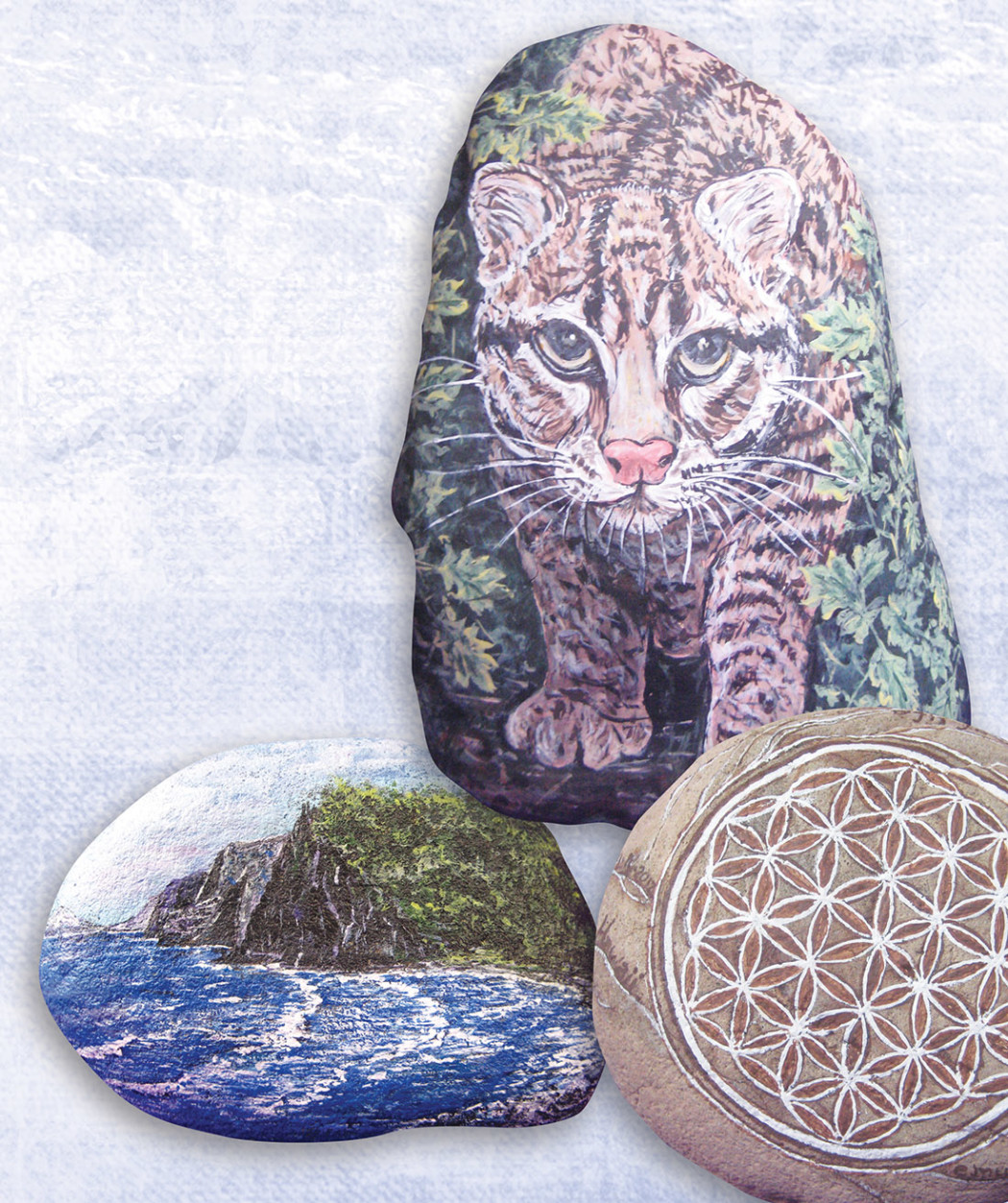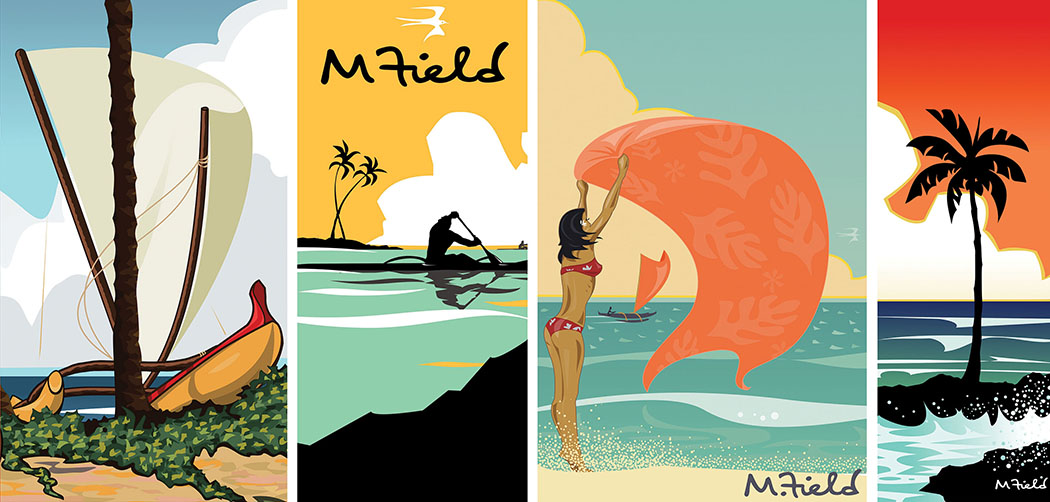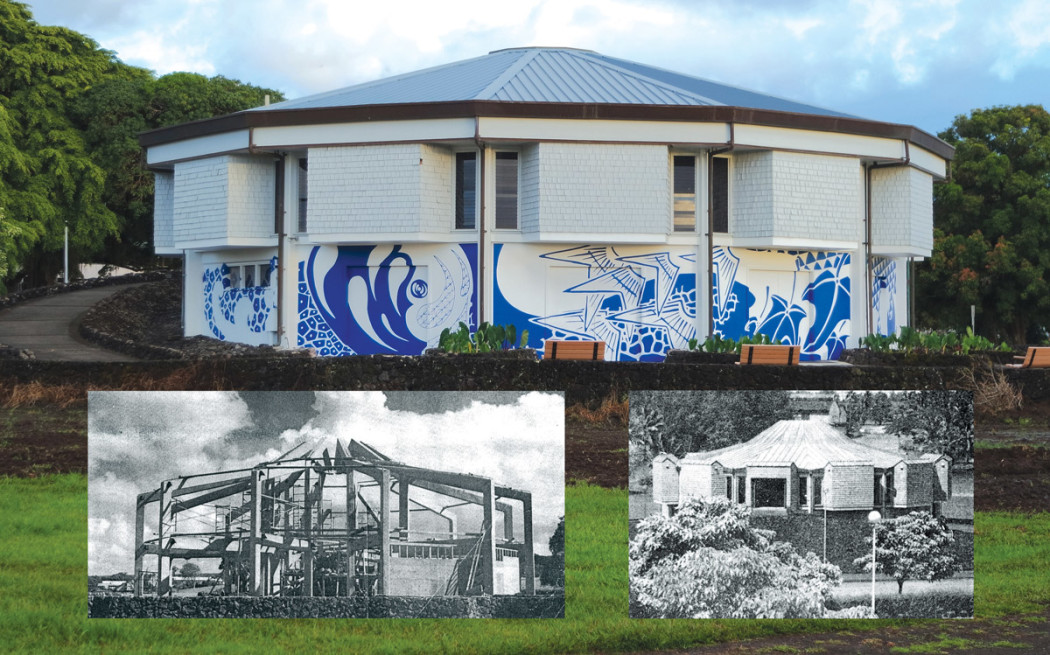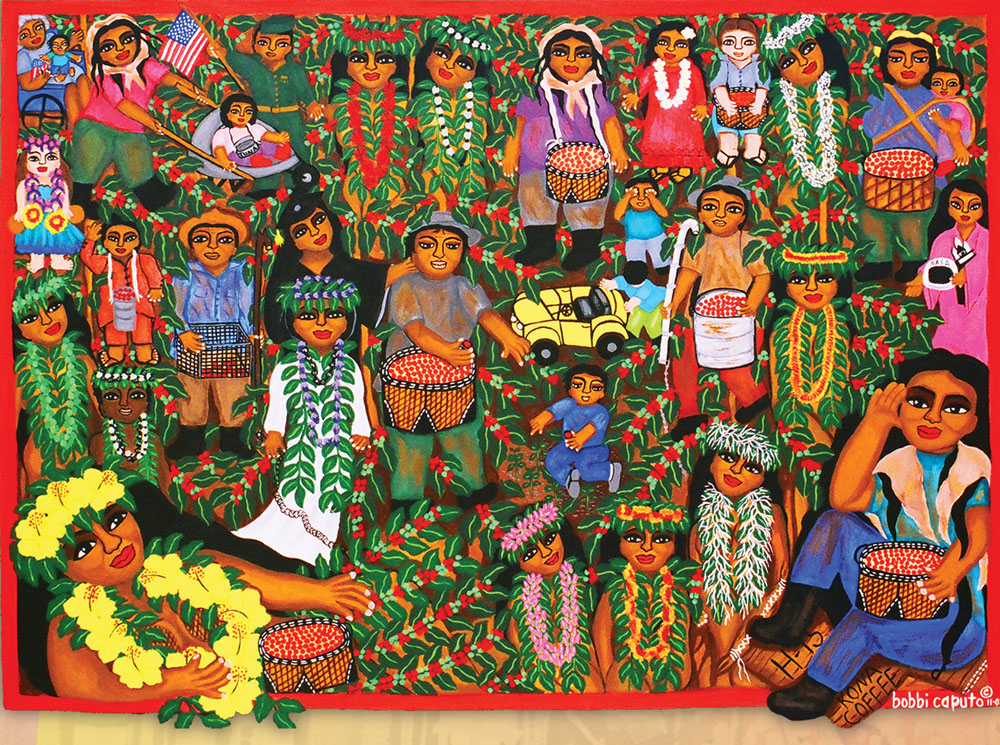
Folk Art of Bobbi Caputo Brings Family Coffee-Picking Memories Back to Life
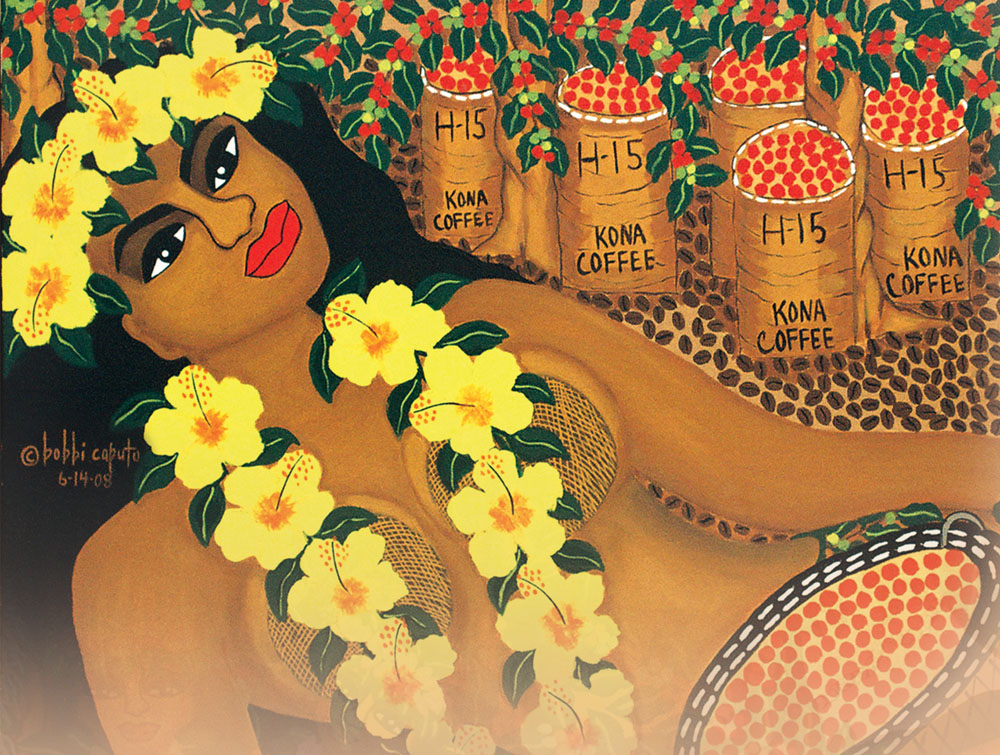
By Hadley Catalano
It’s summer vacation for Bobbi Caputo. It’s the late 1950s and though she hasn’t yet reached adolescence she’s already versed in the ways of the coffee farming world. Sandwiched between Leonora and Faustino Orpilla, her mother and father, and six siblings, Bobbi is used to spending her holidays cultivating, picking and harvesting the trees in the fields of South Kona coffee farms.
During the days when school schedules were aligned with coffee picking season, Bobbi would have rather been anywhere but tucked among the coffee and fruit trees of land parcel H-15, the farm where her father was the caretaker.
“We never had much playtime,“ says Caputo, who has become one of Kona’s best-known folk artists, especially since her “Who Pickin’ Da Coffee” series. “I picked coffee until I left my parent’s house and after I left I never paid much attention to the coffee industry.”
Only after many years of being away from the intimacy of daily coffee farm life could Caputo reflect back, to capture and tell the tale of her childhood through art.

As a child, art was always an underlying passion, but she never had time to indulge in her hobby. To apply her creative imagination while working, she plucked green coffee leaves and used the underside as paper. She sketched on the leaves with a pencil whittled from broken sticks and then explored using nearby mud puddles as an alternate canvas. She melted colored crayons with a matchstick over rocks, cut her own paper dolls, made a mock television set out of cereal boxes and flattened soda bottle caps to make toy rattles.
“My first art sale happened during grade school,” Caputo said, recalling a punch-and-paint foil art project. “I chose tulips in a basket and remember using blues, purples and greens. An old Filipino man—a relative to the family—liked it so much that he asked my mother to have me make two more. I was very surprised that he paid her for them.”
Although she continued to soothe her creative impulses through what she describes as “doodles,” Caputo wasn’t able to fully express herself until her daughter Veralyn, a local contemporary artist, encouraged her.
“She gave me a 20-by-30 canvas,” said Caputo, a self-taught artist who up until 2005 had busied herself with 8-by-10 and smaller, freestyle acrylic paintings. Veralyn informed her mother that she had to do something with the canvas or she was taking it back. It was that threat that prompted Caputo to seek assistance from her friends. “I had no direction, no idea what to do. I wanted to do something worth the weight of the canvas. My friends told me, ‘Why don’t you paint what you know best–coffee picking?’ I thought, ‘How many ways can you paint that?’ I didn’t realize it would grow into memories.” Starting in the middle of the canvas, painting a coffee tree and bag, with no formal fine arts education, Caputo embarked on what would become the first of more than 100 acrylic-on-canvas paintings of her coffee farm memorial series.
“I had no notion of painting a series at the time. I was looking to use the canvas and show my daughter that I had something worth painting.”
Thinking this would be her only piece, Caputo aimed at capturing everything into one painting, cramming in years of childhood memories. Caputo, teaching herself painting techniques along the way, decided to portray her favorite time of the day while working in the fields – Lunchtime.
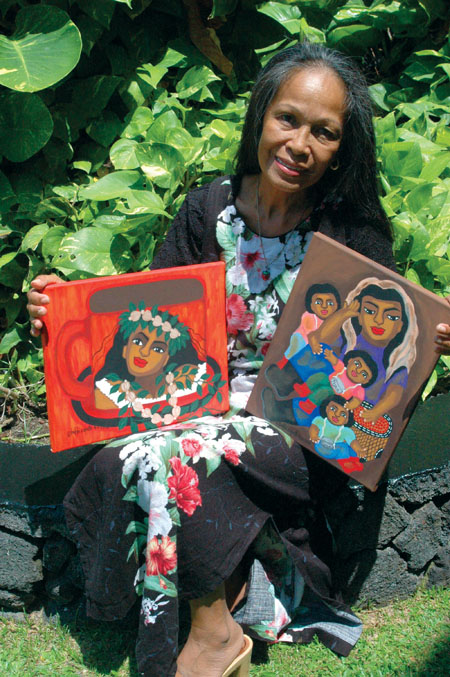
The titled work emerged in bright, coffee-field colors, one-dimensional shapes, intricate details, an innocent beauty and innate sense of design and color balance.
With her folk art style, reminiscent of Norman Rockwell, Grandma Moses or Currier and Ives, Lunchtime reincarnates the midday meal, a time of rest, when Caputo and her family would sit and share a meal amid the freshly plucked trees.
“I remember it so vividly in my mind,” explains Caputo, now a grandmother to nine grandchildren, as she points to images on her canvas. “Here I am at the bottom. I’m still shy about my art so I painted myself with my back facing the audience.”
She continues, describing in rich detail the mango, banana and guava trees that lined the Captain Cook farm on which the family worked. The fruit was incorporated into meals that her mother prepared with rice, fried chicken and sardines. Nestled in the background is a wooden coffee shack, outhouse, chicken coops complete with chickens, an old military jeep, a black Ford car, her parents, two brothers and four sisters.
Weeks later, when the painting was complete, Caputo showed her daughter.
“She couldn’t believe it, she liked it, she laughed,” the artist recalled. “I had painted something meaningful. There was something about going back in time to capture a moment, family unity; it was an awakening of the eyes.”
Motivated to do more, Caputo began work on a second piece in tribute to her father. Painting him inside a coffee cup, Caputo wanted to symbolize the now-profitable Kona Coffee, an industry her father never experienced.
“My father moved to Hawai`i from the Philippines when he was 20 years old,” Caputo explains. “He first worked on a sugar plantation in Hilo before moving to Kona to work on a coffee farm. In the fields there, he met my mom, who was born and raised in Kona,” she says. The second daughter of a family who worked five-acre parcels of coffee from the ground up, but never owned a farm, Caputo wanted to honor his hard work. “My series would become dedicated to him. It’s my way of recognizing his ‘American Dream.’”
Caputo titled her 115-piece series “Who Pickin’ Da Coffee,” from a reoccurring conversation between her mother and father over jobs he tried to get on various farms.
“If he was too late to get the job she would always ask him, ‘Who pickin’ da coffee?’ If it was another family she knew, she was okay because it meant they were getting the income. I was always happy because it wasn’t us. I didn’t realize then the significance. I now understand through my paintings why we picked so much coffee and did what we did as kids. This series is to validate my father’s dream,” she says, noting that each coffee bag is labeled H-15, the five-acre plot number.
Other pieces in the series, which range in size from 4-by-4 to 30-by-40, include Coffee Fields Forever, an illustration of life on the coffee farm; Coffee Cradle, a rendition of her mother and father with one of her siblings in a basket, an image that represents the lack of childcare options of the past; and Children of the Fields–Malama ka ‘aina, a work depicting various people of her past and present. Caputo uses this as a talking piece to represent the continuous cycle of life depicted through the faces of parents, friends, children and grandchildren.

In 2005, Caputo learned about the art exhibition and contest sponsored by the Kona Coffee Festival. She entered five works and initially felt mixed about her participation.
“I felt intimidated by the other artwork and saw for the first time my paintings for what they were. But what stuck with me were the coffee farmers’ reactions when they saw my work. They would laugh and say things like, ‘That’s how it was.’”
For the following coffee festival seasons, Caputo steadily increased her production. She found confidence in her unique folk style, focused on the decorative, cultural representation of traditional coffee farming life.
“I gained a sense of pride and accomplishment. I know now why so many people had asked me if I knew Grandma Moses and other folk artists. The word ‘doodling’ was taken out of my vocabulary and I was introduced to folk art,” she said. Over the past three years at the Kona Coffee Festival, Caputo has been recognized by both professionals and the public for her art. In 2007, she was the recipient of the 1st Place Judges’ Award for Coffee Fields Forever II. In 2008, Children of the Fields–Malama ka ‘aina won the 1st Place People’s Choice Award, and in 2009,Caputo’s painting, No Mo Coffee Already, a large-scale portrait in honor of her mother who had recently passed, won both a 1st Place Judges and 2nd Place People’s Award.
“I don’t know where I am going to go with the series but we’ll see,” Caputo says about “Who Pickin’ Da Coffee,” which will include her latest paintings titled Ordinary Women, a collective of work depicting her mother and younger sisters. Caputo has also been working on a popular series labeled “Island Girls,” a vibrant display of Hawaiian women donning leis and island flowers in her trademark folk-art style.
In the future, the artist hopes to tour her work, making it available particularly for children.
Her motto may be her best educational message: “I am a self-taught artist and when I go to the canvas, I find peace and tranquility in the sanctuary of my art.”
Inspired by local and folk artists alike, Caputo inspires others by painting memories and “capturing feelings and creating original works,” she says, “through my mind’s eye.”
Currently, Caputo has her prints in outlets including Royal Kona Visitor’s Center Mill and Museum, Hualalai Resort Trading Company at the Four Seasons, Kona Coffee and Tea Company, Kona Mountain Coffee (in Kona and on O`ahu), Blue Sky Coffee, Kimura Lauhala Shop, Kona Historical Society Living History Farm, The Gallery at Hilton Waikoloa Village, Kona Art Gallery in Holualoa, Hawaii Treasure Mill, and the Rumley Art Gallery. Her work is displayed at the monthly Kokua Kailua Village Stroll and Hilo Hattie’s in-house artisan program on select days of the week. Her work is also available at konacoffeeart.com. ❖
“Children of the Fields—Malama Ka ‘Aina”:
(to Care, Protect and Preserve the Land)
Bobbi says: “For my 100th piece, I wanted to bring my dad’s American dream full circle on canvas and dedicate the piece to him. I began by painting my dad handing a coffee bean to the youngest (at that time) of our grandchildren, who is pointing to some newly planted coffee seedlings. The bean symbolizes the potential for personal growth and development, while the seedlings stand for the cycle of life and the knowledge and experiences passed on from generation to generation.The girl standing beside my dad, wearing a white dress, is a reflection every little girl’s dream of one day becoming a queen. She preserves the memory of my youngest daughter being crowned a Miss Teen Kona and which pays homage to the role of island queens and their accomplishments.
The soldier holding the American flag represents my oldest brother and the many men and woman in the armed forces. It salutes their dedication and vigilance to protect and preserve our freedom, for me to tell my story.
Both lower corners include renditions from my series; on the right is the self portrait Pickin’ Ain’t Easy which conveys the exhausting toil of a coffee picking day. On the left is Aloha Bean, a postcard pose not found in the coffeelands, adds a little humor to picking coffee.
Although I originally started out painting from a very personal perspective, I came to realize that my family was just like many other ordinary families living on the Big island and working in the coffee industry. With a broader brush the piece eventually became a tribute to all the people that struggled contributed to the success of today’s modern.
Finally, To bring all the neighbor islands together, I inserted renditions of my island maidens wearing flowers leis of the islands to pay respect to our island culture, it’s heritage and aloha spirit. The girls are painted as part of a tree to symbolize the strength foundation that can only be as strong as it’s roots.
I completed the painting with coffee pickers using handmade baskets of wire, bamboo, lauhala and the modern day bucket. The painting pays tribute to the melting pot of families and generations that have worked the land and whose struggles greatly contribution to the success of today’s Kona coffee industry.”
